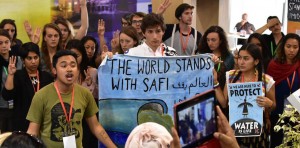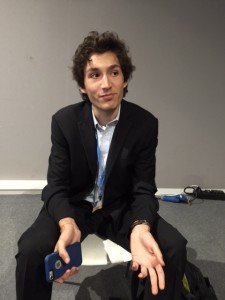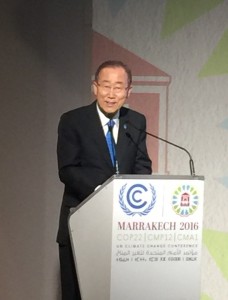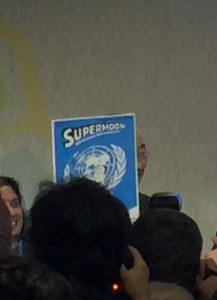One of the more interesting panels I have attended so far was held Tuesday morning (11/15) on “Addressing Conflicts of Interest in the Implementation of the Paris Agreement.” Having attended COP-19 in Warsaw, I was aware of the concern over participation of fossil fuel industries in the conference, of the booths set up by fossil fuel industries that aimed to persuade passers-by that they were environmentally progressive, that Poland (the host country) was heavily reliant upon coal and not ready to switch, and the fact that UNFCCC officials had a meeting with the coal industry during that conference. It seems the involvement of environmentally dirty industries in the COP has become more pervasive since then. The panel, which included Goodwin Ojo from Environmental Rights Action and Friends of the Earth International, Nigeria; Meena Raman of Third World Network, Lidy Nacpil representing Asian Peoples’ Movement for Debt and Development; Walter Schuldt, state delegate to COP from Ecuador; and Tamar Lawrence-Samuel of Corporate Accountability International, explored ways in which conflicts of interest posed problems for climate change negotiations, and how they should be dealt with.
Polluters have increasingly come to participate in the COP. Some years, they have come as representatives of their industries (as BINGOs—business and industry non-governmental actors—don’t you have to love these acronyms?) , and other years they will show up wearing badges of some nation (or the EU) as an official negotiator. Whichever hat they wear, they emphasize private sector interests; when they are delegates, they have a voice in the negotiations. Even as BINGOs, they get access that other non-governmental organizations do not have. Other NGOs (including environmental NGOs and research institutions) do not have the same access to official meetings at COP. BINGOs are able to submit documents (as other NGOs are not). And it looks as if, under UNFCCC auspices, banks direct some monies (adaptation/mitigation, Green Development Fund?) to some of these industries. Tamar Lawrence-Samuel of Corporate Accountability International outlined four ways corporate conflict of interest occurs: 1) direct lobbying by industry, and industry representatives joining official delegations; 2) industry lobby groups with legal status as non-profits who get NGO credentials (World Coal Assn, International Trading Association, etc); 3) Holding big side events that UNFCCC high-level folks attend; and 4) Platform(s) for corporations to pledge to take action on the climate (global climate action plan), and thereby greenwashing their actions.
Walter Schuldt, an official state delegate from Ecuador who was also instrumental in Tuesday’s meeting for consultation with indigenous peoples about the proposed new Platform, pointed out the SBI [Subsidiary Body for Implementation] report at COP22 does not include a conflict of interest statement, despite the efforts of their Latin American group that had support from some African groups. Schuldt, who I was drawn to as one of the rock stars (one of the really good guys) in these meetings, said that a significant part of government climate change expenditures goes through businesses (30%, I believe he said)—yet Corporations have been involved in environmental damages and human rights violations, putting the entire economy of nations in danger when having to press their cases against international corporations (there are examples in his region).
There are good models for conflict of interest rules out there. Schuldt pointed to the World Health Organization (WHO), which has set up a participatory framework for non-state actors. If a conflict of interest exists for a corporation, that entity has to be considered a private sector actor. The Human Rights Council has also worked to develop a binding agreement on international corporations involved in violations of human rights (the EU participated in this). Tamar Lawrence-Samuel (Corporate Accountability International) also pointed to important international examples of keeping industry at arms’ length in the negotiating process. The Global tobacco treaty shows that world leaders can (and have) stood up to powerful corporations. Tobacco interests did everything they could to weaken the agreement, but (Asian-Pacific and other) nations banded together to stop them. The treaty was unanimously adopted in 2003 (provision 5.3 recognizes the tobacco company’s profound and irreconcilable conflict of interest in health policy). This treaty is working, she said, and it helps speed up domestic laws to provide for public health (anti-tobacco laws).
Another point made by two speakers was that the legal systems in some of the LDCs are quite weak, and that national courts’ decisions against polluters (e.g., natural gas flaring in Nigeria, declared illegal in 2005) are often unenforced. They would like some UNFCCC help with the enforcement problem.
Various speakers pointed out that international safeguards and regulations on corporations will not be enough. Our governments can invoke our own right to deal with corporate investors within our countries. International law and regulation for transnational corporations important, of course—and they should be held accountable. It is important to be very careful how “nationally determined contributions” are getting defined to include interests of corporate actors (is coal-produced megawatt power excluded in the 70% reduction in emissions Philippines promised?).
Corporate social responsibility, self-depicted, was called greenwashing by several speakers. Godwin Ojo from Nigeria underscored the failure of voluntary mechanisms: corporations pollute and then build a hospital. Ojo (joined by others) used the term Ecoside to describe such actions. There need to be binding mechanisms, Ojo contended. Delegate Schuldt (Ecuador) pointed out that the achievement of sustainability has not yet been defined for non-developed country funding by UNFCCC, and that definition needs to have teeth.






